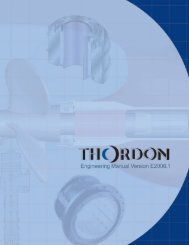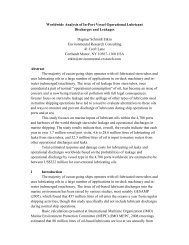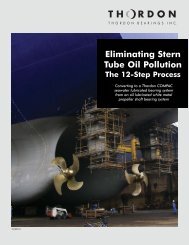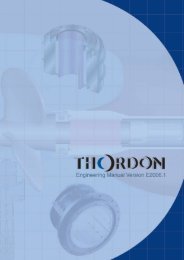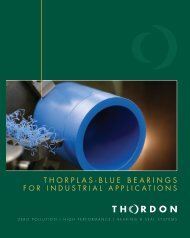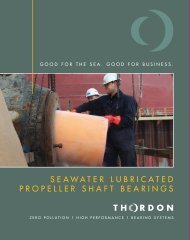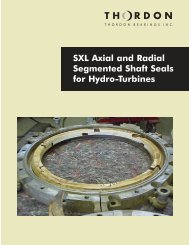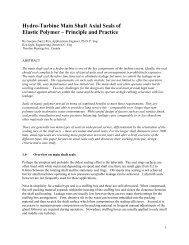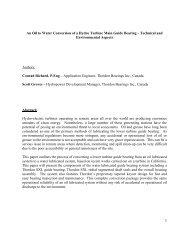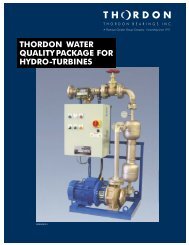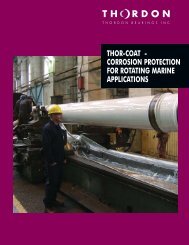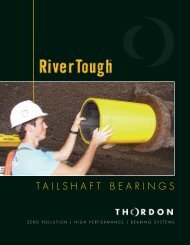Converting An Icebreaker From An Oil ... - Thordon Bearings
Converting An Icebreaker From An Oil ... - Thordon Bearings
Converting An Icebreaker From An Oil ... - Thordon Bearings
Create successful ePaper yourself
Turn your PDF publications into a flip-book with our unique Google optimized e-Paper software.
showed that surprisingly the vessel did not fully conform to the 1984original build drawings! The variances however were small enoughthat it was possible to accommodate them within the parts alreadysupplied.A piano wire was strung through reference points and measurementsfrom it as a datum were taken to determine the relative position of theshaft within the original bearings – this shaft position would need to bereplicated with the new bearings. The forward and aft white metalbearings were then removed and their geometries verified as paralleland concentric, i.e. they had not been machined with offsets nor slope.Figure 1. <strong>Thordon</strong> COMPAC seawater lubricated stern tube bearingsystemBACKGROUNDFirst discussion between the ship owner and <strong>Thordon</strong> <strong>Bearings</strong>regarding the possible conversion of the closed oil lubricated stern tubewith forward and aft seals to an open water lubricated system with onlya forward seal began in late 2006. The <strong>Thordon</strong> Engineering teamreviewed the existing stern tube and shaft arrangements, bearingdrawings, shaft alignment and load calculations for the ice breaker.The vessel is 70m in length with a breadth of 14m and a draft of 5.2m.There are four main engines each 2210 horsepower (1725kW) coupledin pairs through Valmet gearboxes to drive two Wartsila controllablepitch propellers at maximum shaft speed of 240rpm. The propellersoperate inside nozzles.The major topics reviewed by <strong>Thordon</strong> Engineering included: 1) thatspace was available for fitting of shaft liners to Class requiredthickness, 2) that bearing loads were acceptable to Class limits forwater lubricated bearings and 3) determination of bearing offsets andmachining such as required etc. to maintain the existing shaft centerlinealignment. Once these topics were reviewed and achievable, <strong>Thordon</strong>advised the customer the conversion was possible. The proposal from<strong>Thordon</strong> <strong>Bearings</strong> included the design, supply and installation of<strong>Thordon</strong> COMPAC water lubricated propeller shaft bearings incarriers, bronze shaft liners, Thor-Coat shaft coating, <strong>Thordon</strong> WaterQuality Packages, and forward seals. Arrangement drawings for theconversion project were supplied by <strong>Thordon</strong>.Due to demand for its service, scheduling the ice breaker for a sterntube bearing conversion was a difficult decision for the customer and itwas mid-2009 before the order was placed for all conversion parts from<strong>Thordon</strong>. The vessel was then to drydock in the fall of 2009. It isimportant to note that shaft liners and bearing carriers where needed,can have long delivery lead times so it is prudent to begin the planningof an oil lubricated stern tube conversion to water lubricated <strong>Thordon</strong>COMPAC at an early stage.The stern tubes were stripped of all internal pipeworks which werebecoming redundant with the new water lubricated bearings. The newbearing carriers were entered in the stern tube and the piano wire datumre-established. The carrier design included jacking screws at 120°spacing at each end and these were used to correctly position thecarriers relative to the piano wire.Since the new bearings would have a larger clearance than theoriginals, the carriers needed to be installed offset upwards, by anamount equal to 50% of the clearance difference, to replicate the shaftcenterline alignment.The spaces at ends of the carriers were then dammed and Chockfastorange was injected around the carriers – since this was in Canada andgetting late in the year, heating of the stern tube vicinity was requiredfor the chocking operation. Since curing of the chocking resin isexothermic and COMPAC bearings should not be exposed totemperatures above 60°C (140°F), it is preferable to chock the carriersin place empty. The carrier bores had already been fitted with bronzeanti-rotation keys for the COMPAC bearing elements. After curing ofthe resin, repeat measurements to the piano wire confirmed the carrierpositions were still correct.All stern tube internals were then thoroughly cleaned, sandblasted andpainted with anti-corrosion coating. Note - due to delivery timeconstraints for bronze, the ship owner had opted for mild steel bearingcarriers here so these were also coated, etc.<strong>Thordon</strong> COMPAC bearings had been pre-machined to the designdimensions ready for installation. The bearings were slotted to matewith the anti-rotation keys already fitted in the carriers. The bearingelements were freeze-fitted into the carriers - liquid nitrogen was usedas coolant and only 10-15 minutes immersion time was needed toshrink the bearings enough that they were inserted into the carriers byhand. The retaining rings were then fitted and secured to complete thebearing installation.BEARING CONVERSIONWith the vessel drydocked, all oil was drained from the stern tubesystem and the tailshafts removed. Check measurements from theintermediate shafts to the aft bulkhead and sterntube bearing positionsFigure 2. Retaining ring fitted to COMPAC bearing carrierPaper No. ICETECH10-184-R0 Ogle Page number: 2



